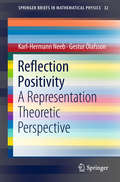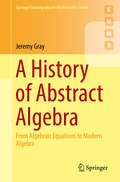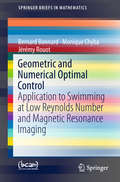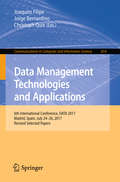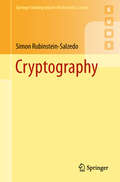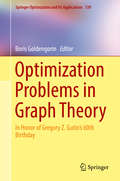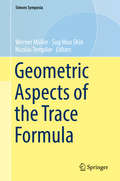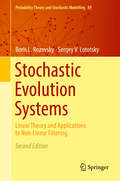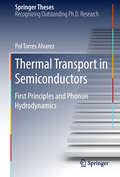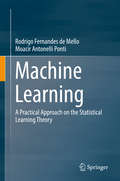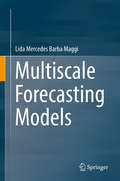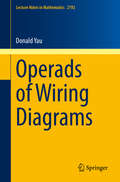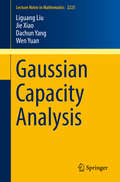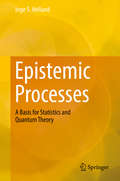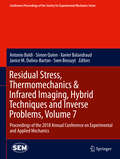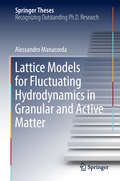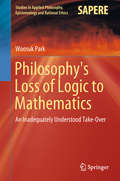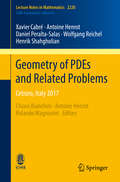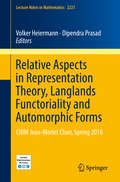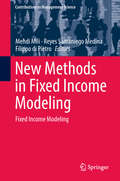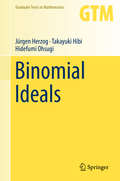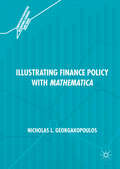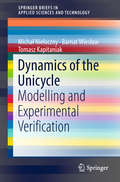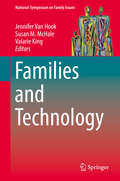- Table View
- List View
Reflection Positivity: A Representation Theoretic Perspective (SpringerBriefs in Mathematical Physics #32)
by Karl-Hermann Neeb Gestur ÓlafssonRefection Positivity is a central theme at the crossroads of Lie group representations, euclidean and abstract harmonic analysis, constructive quantum field theory, and stochastic processes.This book provides the first presentation of the representation theoretic aspects of Refection Positivity and discusses its connections to those different fields on a level suitable for doctoral students and researchers in related fields.It starts with a general introduction to the ideas and methods involving refection positive Hilbert spaces and the Osterwalder--Schrader transform. It then turns to Reflection Positivity in Lie group representations. Already the case of one-dimensional groups is extremely rich.For the real line it connects naturally with Lax--Phillips scattering theory and for the circle group it provides a new perspective on the Kubo--Martin--Schwinger (KMS) condition for states of operator algebras. For Lie groups Reflection Positivity connects unitary representations of a symmetric Lie group with unitary representations of its Cartan dual Lie group.A typical example is the duality between the Euclidean group E(n) and the Poincare group P(n) of special relativity. It discusses in particular the curved context of the duality between spheres and hyperbolic spaces. Further it presents some new integration techniques for representations of Lie algebras by unbounded operators which are needed for the passage to the dual group. Positive definite functions, kernels and distributions and used throughout as a central tool.
A History of Abstract Algebra: From Algebraic Equations to Modern Algebra (Springer Undergraduate Mathematics Series)
by Jeremy GrayThis textbook provides an accessible account of the history of abstract algebra, tracing a range of topics in modern algebra and number theory back to their modest presence in the seventeenth and eighteenth centuries, and exploring the impact of ideas on the development of the subject. Beginning with Gauss’s theory of numbers and Galois’s ideas, the book progresses to Dedekind and Kronecker, Jordan and Klein, Steinitz, Hilbert, and Emmy Noether. Approaching mathematical topics from a historical perspective, the author explores quadratic forms, quadratic reciprocity, Fermat’s Last Theorem, cyclotomy, quintic equations, Galois theory, commutative rings, abstract fields, ideal theory, invariant theory, and group theory. Readers will learn what Galois accomplished, how difficult the proofs of his theorems were, and how important Camille Jordan and Felix Klein were in the eventual acceptance of Galois’s approach to the solution of equations. The book also describes the relationship between Kummer’s ideal numbers and Dedekind’s ideals, and discusses why Dedekind felt his solution to the divisor problem was better than Kummer’s. Designed for a course in the history of modern algebra, this book is aimed at undergraduate students with an introductory background in algebra but will also appeal to researchers with a general interest in the topic. With exercises at the end of each chapter and appendices providing material difficult to find elsewhere, this book is self-contained and therefore suitable for self-study.
Geometric and Numerical Optimal Control: Application to Swimming at Low Reynolds Number and Magnetic Resonance Imaging (SpringerBriefs in Mathematics)
by Bernard Bonnard Monique Chyba Jérémy RouotThis book introduces readers to techniques of geometric optimal control as well as the exposure and applicability of adapted numerical schemes. It is based on two real-world applications, which have been the subject of two current academic research programs and motivated by industrial use – the design of micro-swimmers and the contrast problem in medical resonance imaging. The recently developed numerical software has been applied to the cases studies presented here. The book is intended for use at the graduate and Ph.D. level to introduce students from applied mathematics and control engineering to geometric and computational techniques in optimal control.
Data Management Technologies and Applications: 6th International Conference, DATA 2017, Madrid, Spain, July 24–26, 2017, Revised Selected Papers (Communications in Computer and Information Science #814)
by Joaquim Filipe Jorge Bernardino Christoph QuixThis book constitutes the thoroughly refereed proceedings of the 6th International Conference on Data Management Technologies and Applications, DATA 2017, held in Madrid, Spain, in July 2017. The 13 revised full papers were carefully reviewed and selected from 66 submissions. The papers deal with the following topics: databases, big data, data mining, data management, data security, and other aspects of information systems and technology involving advanced applications of data.
Cryptography (Springer Undergraduate Mathematics Series)
by Simon Rubinstein-SalzedoThis text introduces cryptography, from its earliest roots to cryptosystems used today for secure online communication.Beginning with classical ciphers and their cryptanalysis, this book proceeds to focus on modern public key cryptosystems such as Diffie-Hellman, ElGamal, RSA, and elliptic curve cryptography with an analysis of vulnerabilities of these systems and underlying mathematical issues such as factorization algorithms. Specialized topics such as zero knowledge proofs, cryptographic voting, coding theory, and new research are covered in the final section of this book.Aimed at undergraduate students, this book contains a large selection of problems, ranging from straightforward to difficult, and can be used as a textbook for classes as well as self-study. Requiring only a solid grounding in basic mathematics, this book will also appeal to advanced high school students and amateur mathematicians interested in this fascinating and topical subject.
Optimization Problems in Graph Theory: In Honor of Gregory Z. Gutin's 60th Birthday (Springer Optimization and Its Applications #139)
by Boris GoldengorinThis book presents open optimization problems in graph theory and networks. Each chapter reflects developments in theory and applications based on Gregory Gutin’s fundamental contributions to advanced methods and techniques in combinatorial optimization. Researchers, students, and engineers in computer science, big data, applied mathematics, operations research, algorithm design, artificial intelligence, software engineering, data analysis, industrial and systems engineering will benefit from the state-of-the-art results presented in modern graph theory and its applications to the design of efficient algorithms for optimization problems. Topics covered in this work include:· Algorithmic aspects of problems with disjoint cycles in graphs· Graphs where maximal cliques and stable sets intersect· The maximum independent set problem with special classes· A general technique for heuristic algorithms for optimization problems · The network design problem with cut constraints· Algorithms for computing the frustration index of a signed graph· A heuristic approach for studying the patrol problem on a graph· Minimum possible sum and product of the proper connection number· Structural and algorithmic results on branchings in digraphs · Improved upper bounds for Korkel--Ghosh benchmark SPLP instances
Geometric Aspects of the Trace Formula (Simons Symposia)
by Werner Müller Sug Woo Shin Nicolas TemplierThe second of three volumes devoted to the study of the trace formula, these proceedings focus on automorphic representations of higher rank groups. Based on research presented at the 2016 Simons Symposium on Geometric Aspects of the Trace Formula that took place in Schloss Elmau, Germany, the volume contains both original research articles and articles that synthesize current knowledge and future directions in the field. The articles discuss topics such as the classification problem of representations of reductive groups, the structure of Langlands and Arthur packets, interactions with geometric representation theory, and conjectures on the global automorphic spectrum. Suitable for both graduate students and researchers, this volume presents the latest research in the field. Readers of the first volume Families of Automorphic Forms and the Trace Formula will find this a natural continuation of the study of the trace formula.
Stochastic Evolution Systems: Linear Theory and Applications to Non-Linear Filtering (Probability Theory and Stochastic Modelling #89)
by Boris L. Rozovsky Sergey V. LototskyThis monograph, now in a thoroughly revised second edition, develops the theory of stochastic calculus in Hilbert spaces and applies the results to the study of generalized solutions of stochastic parabolic equations. The emphasis lies on second-order stochastic parabolic equations and their connection to random dynamical systems. The authors further explore applications to the theory of optimal non-linear filtering, prediction, and smoothing of partially observed diffusion processes. The new edition now also includes a chapter on chaos expansion for linear stochastic evolution systems. This book will appeal to anyone working in disciplines that require tools from stochastic analysis and PDEs, including pure mathematics, financial mathematics, engineering and physics.
Thermal Transport in Semiconductors: First Principles and Phonon Hydrodynamics (Springer Theses)
by Pol Torres AlvarezStarting from a broad overview of heat transport based on the Boltzmann Transport Equation, this book presents a comprehensive analysis of heat transport in bulk and nanomaterials based on a kinetic-collective model (KCM). This has become key to understanding the field of thermal transport in semiconductors, and represents an important stride. The book describes how heat transport becomes hydrodynamic at the nanoscale, propagating very much like a viscous fluid and manifesting vorticity and friction-like behavior. It introduces a generalization of Fourier’s law including a hydrodynamic term based on collective behavior in the phonon ensemble. This approach makes it possible to describe in a unifying way recent experiments that had to resort to unphysical assumptions in order to uphold the validity of Fourier’s law, demonstrating that hydrodynamic heat transport is a pervasive type of behavior in semiconductors at reduced scales.
Machine Learning: A Practical Approach on the Statistical Learning Theory
by Rodrigo Fernandes de Mello Moacir Antonelli PontiThis book presents the Statistical Learning Theory in a detailed and easy to understand way, by using practical examples, algorithms and source codes. It can be used as a textbook in graduation or undergraduation courses, for self-learners, or as reference with respect to the main theoretical concepts of Machine Learning. Fundamental concepts of Linear Algebra and Optimization applied to Machine Learning are provided, as well as source codes in R, making the book as self-contained as possible.It starts with an introduction to Machine Learning concepts and algorithms such as the Perceptron, Multilayer Perceptron and the Distance-Weighted Nearest Neighbors with examples, in order to provide the necessary foundation so the reader is able to understand the Bias-Variance Dilemma, which is the central point of the Statistical Learning Theory.Afterwards, we introduce all assumptions and formalize the Statistical Learning Theory, allowing the practical study of different classification algorithms. Then, we proceed with concentration inequalities until arriving to the Generalization and the Large-Margin bounds, providing the main motivations for the Support Vector Machines. From that, we introduce all necessary optimization concepts related to the implementation of Support Vector Machines. To provide a next stage of development, the book finishes with a discussion on SVM kernels as a way and motivation to study data spaces and improve classification results.
Multiscale Forecasting Models
by Lida Mercedes Barba MaggiThis book presents two new decomposition methods to decompose a time series in intrinsic components of low and high frequencies. The methods are based on Singular Value Decomposition (SVD) of a Hankel matrix (HSVD). The proposed decomposition is used to improve the accuracy of linear and nonlinear auto-regressive models. Linear Auto-regressive models (AR, ARMA and ARIMA) and Auto-regressive Neural Networks (ANNs) have been found insufficient because of the highly complicated nature of some time series. Hybrid models are a recent solution to deal with non-stationary processes which combine pre-processing techniques with conventional forecasters, some pre-processing techniques broadly implemented are Singular Spectrum Analysis (SSA) and Stationary Wavelet Transform (SWT). Although the flexibility of SSA and SWT allows their usage in a wide range of forecast problems, there is a lack of standard methods to select their parameters. The proposed decomposition HSVD and Multilevel SVD are described in detail through time series coming from the transport and fishery sectors. Further, for comparison purposes, it is evaluated the forecast accuracy reached by SSA and SWT, both jointly with AR-based models and ANNs.
Operads of Wiring Diagrams (Lecture Notes in Mathematics #2192)
by Donald YauWiring diagrams form a kind of graphical language that describes operations or processes with multiple inputs and outputs, and shows how such operations are wired together to form a larger and more complex operation. This monograph presents a comprehensive study of the combinatorial structure of the various operads of wiring diagrams, their algebras, and the relationships between these operads.The book proves finite presentation theorems for operads of wiring diagrams as well as their algebras. These theorems describe the operad in terms of just a few operadic generators and a small number of generating relations. The author further explores recent trends in the application of operad theory to wiring diagrams and related structures, including finite presentations for the propagator algebra, the algebra of discrete systems, the algebra of open dynamical systems, and the relational algebra. A partial verification of David Spivak’s conjecture regarding the quotient-freeness of the relational algebra is also provided. In the final part, the author constructs operad maps between the various operads of wiring diagrams and identifies their images. Assuming only basic knowledge of algebra, combinatorics, and set theory, this book is aimed at advanced undergraduate and graduate students as well as researchers working in operad theory and its applications. Numerous illustrations, examples, and practice exercises are included, making this a self-contained volume suitable for self-study.
Gaussian Capacity Analysis (Lecture Notes in Mathematics #2225)
by Liguang Liu Jie Xiao Dachun Yang Wen YuanThis monograph develops the Gaussian functional capacity theory with applications to restricting the Gaussian Campanato/Sobolev/BV space. Included in the text is a new geometric characterization of the Gaussian 1-capacity and the Gaussian Poincaré 1-inequality. Applications to function spaces and geometric measures are also presented. This book will be of use to researchers who specialize in potential theory, elliptic differential equations, functional analysis, probability, and geometric measure theory.
Epistemic Processes: A Basis for Statistics and Quantum Theory
by Inge S. HellandThis book discusses a link between statistical theory and quantum theory based on the concept of epistemic processes – which can be e.g. statistical investigations or quantum mechanical measurements, and refer to processes that are used to gain knowledge about something. The book addresses a range of topics, including a derivation of the Born formula from reasonable assumptions, a derivation of the Schrödinger equation in the one-dimensional case, and a discussion of the Bell inequality from an epistemic perspective. The book describes a possible epistemic foundation of quantum theory. Lastly, it presents a general philosophical discussion of the approach, which, principally speaking, is not restricted to the micro-world. Hence the book can also be seen as a motivation for further research into quantum decision theory and quantum models for cognition. The book will benefit a broad readership, including physicists and statisticians interested in the foundation of their disciplines, philosophers of science and graduate students, and anyone with a reasonably good background in mathematics and an open mind.
Residual Stress, Thermomechanics & Infrared Imaging, Hybrid Techniques and Inverse Problems, Volume 7: Proceedings of the 2018 Annual Conference on Experimental and Applied Mechanics (Conference Proceedings of the Society for Experimental Mechanics Series)
by Antonio Baldi Simon Quinn Xavier Balandraud Janice M. Dulieu-Barton Sven BossuytResidual Stress, Thermomechanics & Infrared Imaging, Hybrid Techniques and Inverse Problems, Volume 7 of the Proceedings of the 2018 SEM Annual Conference & Exposition on Experimental and Applied Mechanics, the seventh volume of eight from the Conference, brings together contributions to this important area of research and engineering. The collection presents early findings and case studies on a wide range of areas, including: Inverse Problems/Hybrid TechniquesMaterial Characterizations Using ThermographyThermoelastic Stress AnalysisFatigue & Damage Evaluation Using Infrared ThermographyIntegration of Infrared Thermography & DICThermographic Non-Destructive Evaluation (NDE)
Lattice Models for Fluctuating Hydrodynamics in Granular and Active Matter (Springer Theses)
by Alessandro ManacordaThis book investigates the common nature of granular and active systems, which is rooted in their intrinsic out-of-equilibrium behavior, with the aim of finding minimal models able to reproduce and predict the complex collective behavior observed in experiments and simulations. Granular and active matter are among the most studied systems in out-of-equilibrium statistical physics. The book guides readers through the derivation of a fluctuating hydrodynamic description of granular and active matter by means of controlled and transparent mathematical assumptions made on a lattice model. It also shows how a macroscopic description can be provided from microscopic requirements, leading to the prediction of collective states such as cooling, swarming, clustering and the transitions among them. The analytical and numerical results shed new light on the physical connection between the local, microscopic properties of few particles and the macroscopic collective motion of the whole system.
Philosophy's Loss of Logic to Mathematics: An Inadequately Understood Take-Over (Studies in Applied Philosophy, Epistemology and Rational Ethics #43)
by Woosuk ParkThis book offers a historical explanation of important philosophical problems in logic and mathematics, which have been neglected by the official history of modern logic. It offers extensive information on Gottlob Frege’s logic, discussing which aspects of his logic can be considered truly innovative in its revolution against the Aristotelian logic. It presents the work of Hilbert and his associates and followers with the aim of understanding the revolutionary change in the axiomatic method. Moreover, it offers useful tools to understand Tarski’s and Gödel’s work, explaining why the problems they discussed are still unsolved. Finally, the book reports on some of the most influential positions in contemporary philosophy of mathematics, i.e., Maddy’s mathematical naturalism and Shapiro’s mathematical structuralism. Last but not least, the book introduces Biancani’s Aristotelian philosophy of mathematics as this is considered important to understand current philosophical issue in the applications of mathematics. One of the main purposes of the book is to stimulate readers to reconsider the Aristotelian position, which disappeared almost completely from the scene in logic and mathematics in the early twentieth century.
Geometry of PDEs and Related Problems: Cetraro, Italy 2017 (Lecture Notes in Mathematics #2220)
by Xavier Cabré Antoine Henrot Daniel Peralta-Salas Wolfgang Reichel Henrik Shahgholian Chiara Bianchini Rolando MagnaniniThe aim of this book is to present different aspects of the deep interplay between Partial Differential Equations and Geometry. It gives an overview of some of the themes of recent research in the field and their mutual links, describing the main underlying ideas, and providing up-to-date references.Collecting together the lecture notes of the five mini-courses given at the CIME Summer School held in Cetraro (Cosenza, Italy) in the week of June 19–23, 2017, the volume presents a friendly introduction to a broad spectrum of up-to-date and hot topics in the study of PDEs, describing the state-of-the-art in the subject. It also gives further details on the main ideas of the proofs, their technical difficulties, and their possible extension to other contexts. Aiming to be a primary source for researchers in the field, the book will attract potential readers from several areas of mathematics.
Relative Aspects in Representation Theory, Langlands Functoriality and Automorphic Forms: CIRM Jean-Morlet Chair, Spring 2016 (Lecture Notes in Mathematics #2221)
by Volker Heiermann Dipendra PrasadThis volume presents a panorama of the diverse activities organized by V. Heiermann and D. Prasad in Marseille at the CIRM for the Chaire Morlet event during the first semester of 2016. It assembles together expository articles on topics which previously could only be found in research papers. Starting with a very detailed article by P. Baumann and S. Riche on the geometric Satake correspondence, the book continues with three introductory articles on distinguished representations due to P. Broussous, F. Murnaghan, and O. Offen; an expository article of I. Badulescu on the Jacquet–Langlands correspondence; a paper of J. Arthur on functoriality and the trace formula in the context of "Beyond Endoscopy", taken from the Simons Proceedings; an article of W-W. Li attempting to generalize Godement–Jacquet theory; and a research paper of C. Moeglin and D. Renard, applying the trace formula to the local Langlands classification for classical groups. The book should be of interest to students as well as professional researchers working in the broad area of number theory and representation theory.
New Methods in Fixed Income Modeling: Fixed Income Modeling (Contributions to Management Science)
by Mehdi Mili Reyes Samaniego Medina Filippo Di PietroThis book presents new approaches to fixed income modeling and portfolio management techniques. Taking into account the latest mathematical and econometric developments in finance, it analyzes the hedging securities and structured instruments that are offered by banks, since recent research in the field of fixed incomes and financial markets has raised awareness for changes in market risk management strategies. The book offers a valuable resource for all researchers and practitioners interested in the theory behind fixed income instruments, and in their applications in financial portfolio management.
Binomial Ideals (Graduate Texts in Mathematics #279)
by Jürgen Herzog Takayuki Hibi Hidefumi OhsugiThis textbook provides an introduction to the combinatorial and statistical aspects of commutative algebra with an emphasis on binomial ideals. In addition to thorough coverage of the basic concepts and theory, it explores current trends, results, and applications of binomial ideals to other areas of mathematics. The book begins with a brief, self-contained overview of the modern theory of Gröbner bases and the necessary algebraic and homological concepts from commutative algebra. Binomials and binomial ideals are then considered in detail, along with a short introduction to convex polytopes. Chapters in the remainder of the text can be read independently and explore specific aspects of the theory of binomial ideals, including edge rings and edge polytopes, join-meet ideals of finite lattices, binomial edge ideals, ideals generated by 2-minors, and binomial ideals arising from statistics. Each chapter concludes with a set of exercises and a list of related topics and results that will complement and offer a better understanding of the material presented.Binomial Ideals is suitable for graduate students in courses on commutative algebra, algebraic combinatorics, and statistics. Additionally, researchers interested in any of these areas but familiar with only the basic facts of commutative algebra will find it to be a valuable resource.
Illustrating Finance Policy with Mathematica (Quantitative Perspectives on Behavioral Economics and Finance)
by Nicholas L. GeorgakopoulosStudents in various disciplines—from law and government to business and health policy—need to understand several quantitative aspects of finance (such as the capital asset pricing model or financial options) and policy analysis (e.g., assessing the weight of probabilistic evidence) but often have little quantitative background. This book illustrates those phenomena and explains how to illustrate them using the powerful visuals that computing can produce. Of particular interest to graduate students and scholars in need of sharper quantitative methods, this book introduces the reader to Mathematica, enables readers to use Mathematica to produce their own illustrations, and places specific emphasis on finance and policy as well as the foundations of probability theory.
Illustrating Finance Policy with Mathematica (Quantitative Perspectives on Behavioral Economics and Finance)
by Nicholas L. GeorgakopoulosStudents in various disciplines—from law and government to business and health policy—need to understand several quantitative aspects of finance (such as the capital asset pricing model or financial options) and policy analysis (e.g., assessing the weight of probabilistic evidence) but often have little quantitative background. This book illustrates those phenomena and explains how to illustrate them using the powerful visuals that computing can produce. Of particular interest to graduate students and scholars in need of sharper quantitative methods, this book introduces the reader to Mathematica, enables readers to use Mathematica to produce their own illustrations, and places specific emphasis on finance and policy as well as the foundations of probability theory.
Dynamics of the Unicycle: Modelling and Experimental Verification (SpringerBriefs in Applied Sciences and Technology)
by Michał Niełaczny Barnat Wiesław Tomasz KapitaniakThis book presents a three-dimensional model of the complete unicycle–unicyclist system. A unicycle with a unicyclist on it represents a very complex system. It combines Mechanics, Biomechanics and Control Theory into the system, and is impressive in both its simplicity and improbability. Even more amazing is the fact that most unicyclists don’t know that what they’re doing is, according to science, impossible – just like bumblebees theoretically shouldn’t be able to fly. This book is devoted to the problem of modeling and controlling a 3D dynamical system consisting of a single-wheeled vehicle, namely a unicycle and the cyclist (unicyclist) riding it. The equations of motion are derived with the aid of the rarely used Boltzmann–Hamel Equations in Matrix Form, which are based on quasi-velocities. The Matrix Form allows Hamel coefficients to be automatically generated, and eliminates all the difficulties associated with determining these quantities. The equations of motion are solved by means of Wolfram Mathematica. To more faithfully represent the unicyclist as part of the model, the model is extended according to the main principles of biomechanics. The impact of the pneumatic tire is investigated using the Pacejka Magic Formula model including experimental determination of the stiffness coefficient. The aim of control is to maintain the unicycle–unicyclist system in an unstable equilibrium around a given angular position. The control system, based on LQ Regulator, is applied in Wolfram Mathematica. Lastly, experimental validation, 3D motion capture using software OptiTrack – Motive:Body and high-speed cameras are employed to test the model’s legitimacy. The description of the unicycle–unicyclist system dynamical model, simulation results, and experimental validation are all presented in detail.
Families and Technology (National Symposium on Family Issues #9)
by Jennifer Van Hook Susan M. McHale Valarie KingThis timely reference takes a rigorous look at the myriad ways technology, from smartphones to dating apps to social media, is affecting family life and opening new areas for study. The book features cross-disciplinary perspectives on current trends in the role of technology in couple and family contexts. It focuses on the roles of parents in monitoring children’s screen time, of technology in relationship formation, and of technology in changing family dynamics. Nuanced coverage considers the emerging conflicts and paradoxes associated with digital family life—closeness versus isolation, children versus parents as experts, and privacy versus surveillance. Contributors also identify new research opportunities as family roles and structures continue to evolve and technology becomes a greater lens for family studies.Among the topics covered:How parents manage young children’s mobile media useAdolescents as the family technology innovatorsOnline dating: changing intimacy one swipe at a timeTechnology in relational systems: roles, rules, and boundariesTelevision “effects” on international family changeInterplay between families and technology: future investigationsFamilies and Technology is a valuable resource for researchers and students in the fields of family studies, sociology, marriage and family therapy, social welfare, public health, and psychology. The book also appeals to policymakers and human services personnel dedicated to better understanding the impact of rapidly spreading technologies on families around the globe.
